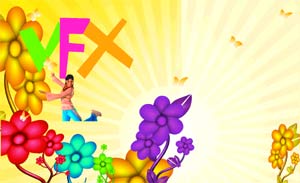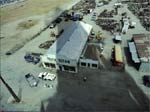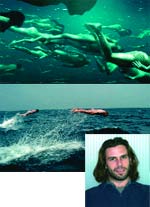What makes those spot effects so special? Much of the credit goes to agency creatives and their clever boards. The rest can be attributed to the creative input and techniques of the visual effects artists and editors whose fertile imaginations explore options unforeseen.
Charlex in New York ( www.charlex. com) created the effects work on the Looney Toons/Kids AOL commercial starring Brendan Fraser. In the :30 spot, Fraser and a young boy watch his new movie on a computer screen, talk about how cartoon characters can't hurt you and then, of course, that CG anvil comes crashing from the sky, knocking Fraser through the floor. But watch through the end for another cute animated bit: the little AOL running man also dodges a falling anvil. Charlex created that in a test that won them the job.

For New York radio station Z-100, Earth2Mars; Eric Robel used Avid Illusion to put various musical artists into Times Square and its surroundings.
|
"That test really blew everybody away. A lot of times there's a standard ending where the AOL running man stands there, holds up a card that says something, then he flings the card and you see the AOL logo," says senior producer Steve Chiarello. "In this case, they were allowed to try something else, so we did a test where running man is standing there, you hear the sound of the anvil coming, he steps aside, the anvil crashes down next to him, and he holds up a sign that says, 'Life needs kids' stuff,' then he flips the sign around and it says AOL. Then we added a little Looney Toons ending with circles."
Charlex had worked with BBDO, the agency client, before, even on AOL spots, but this project involved new producers and the different Kids AOL account. These new guys requested a 3D reel, which Charlex tailored with its AOL work, creating a pretty good "in" but the animated tag test clinched the deal. Adds John Zawisha, Charlex senior effects editor, "We have a good working relationship with agencies. They give us room to explore. We provide them with choices and we help them develop their ideas."
The Looney Toons effects work was two fold: computer screenshots and the 3D/live-action creation and integration. The screenshots involved re-creating actual Kids AOL screens that were large and simple enough to read in :01-:02. Discreet Flame was used for the compositing and animation by Marc Goldfine. Zawisha edited on Smoke. For the 3D anvil and other cartoon elements, Tony Tabtong and Alex Cheparev used Alias Maya for all animation and modeling. Rendering was done in Mental Images Mental Ray. Toon Shading gave it the special 2D Warner Bros. cartoon look. Charlex created an outline shader for the cartoons and combined it with a flat shader for the color fill.

A52 used Side Effects and Quantel Henry on this Rocket spot for Hewlett Packard.
|
"We actually did write some scripts to ease the transition because the Mental Ray program doesn't work that well with Maya right now so we used MEL scripting to go through the routine task of assigning these shaders, which often is a lengthy process to do by hand," says Charlex CG supervisor Bryan Godwin. "We'll [write script] on a per-job-basis or, for something like Toon shading, which we'll do on several jobs, we have these master scripts that ease the set-ups from job to job."
BELIEF'S ONE FINE DAY
Belief (www.belief.com) in Los Angeles created a :30 for Mervyn's department store that is reminiscent of The Beatles' Yellow Submarine cartoon style. The client, Ron Foth Advertising, Columbus, OH, kept referencing that movie for the playful spot that was set to a remake of the 1950s song "One Fine Day." Rough boards were handed to the Belief animator/designers who took it from there. The spot aired this past fall.
Trying to create a narrative from footage that was shot before a linear storyline existed was the big challenge. Motion control was not used during the shoot so it was a little tricky to track shots of people leapfrogging over flowers and then composite them into the graphic background.
"Clients want things shot simply but when the idea grows in complexity, the post house has to solve those problems," says Belief executive creative director/founder Mike Goedecke. "In this case, we needed to make it seamless with what looked like continuous shots. I was brought in to supervise the shoot from a technical standpoint and that helped because I was able to get additional shots that gave us more options in post."

Charlex added an animated anvil to this AOL commercial's end-tag during the test spot. The client like it so much they kept it in.
|
Belief has worked on Mervyn projects with this agency before. They have developed a relationship where the agency's own director, Ron Foth, Jr., who does a lot of greenscreen spots, now prefers that Belief supervise the shoots so they can push it creatively in post.
Jake Portman and Rick Gledhill, both animator/designers, used Maxon's Cinema 4D to create the animation and After Effects for compositing. The software runs on Mac G5s.
A52'S MISSION: ROCKET TO MARS
LA's A52 (www.A52com) continues to work with director Jake Scott and agency Goodby Silverstein & Partners, San Francisco, on the Hewlett Packard campaign, which teams the technology partner with various companies, in this case Disney on a :30 called Rocket Delivery. The director sought to harness the ideas of Simon Brewster, A52's visual effects supervisor and lead Inferno artist.
"Jake and Simon were working hand in hand early on, looking at models, drawings, trying to figure out what does the rocket look like, how does it work in this environment," explains senior producer Scott Boyajan. "The other interesting thing was the relationship between the models shot and created, and how our CGI was brought into the process - the live-action art direction, and the 2D and 3D integration."

People as dolphins: For Johnnie Walker -- Fish, Jake Mengers (inset) used Alias Maya V.4.5 for animation and rendering.
|
Throughout the entire spot, a big, looming shadow traverses city and country. At end, viewers realize it's a rocket that's being delivered to a boy's home so he can take a trip to Mars. A voiceover says, "Bringing space travel to families everywhere. Disney used HP technology to help create Mission: Space, the new thrill ride at EPCOT." The tagline is "HP + Disney." This :30 is currently being reworked into a :60 and may ultimately go to cinema release.
Denis Gauthier and Westley Sarokin, both CGI artists, used Side Effects Houdini on an SGI Octane for the 3D. Scott Johnson was the Quantel Henry artist. Darcy Leslie Parsons was executive producer.
The 3D was used to create the photoreal rocket and to project the rocket shadow on the ground, which had to be modeled and contoured to include sheds and cars. The rocket's path had to be camera tracked, overlaid with geometry and had to have the shadow projected on top. In the two scenes where the boy looks up at the rocket, the bottom is a model while the top is CG. Brewster put it all together in the composite.
"It developed all the way through because there were a lot of editorial changes as shots came and went," says Brewster, adding, "you use the tools to create the shape. You have to use your eyes to make it composite properly. It's not always about the tools; it's about the people. You cut through a lot of nonsense when you've got experienced artists working on the job."
That said, experienced artists using tried-and-true tools are particularly efficient.
EARTH2MARS CLEARS TIMES SQUARE
Eric Robel, compositor/visual effects artist at NYC's Earth2Mars (www.earth2mars. com) used an Avid Illusion on an SGI Octane that is adept at matte manipulation on a fall campaign for Z100, a local radio station. The agency was NYC's HQ Productions.
The :15s and :30s all take place in Times Square and feature Britney Spears, Kelly Clarkson, Carson Daly and Ashanti. All were shot in the studio on greenscreen; the background plates were shot on 35mm with motion control. Robel also had to add radio station logos and neon to Times Square, plus add different artists to video screens sprinkled throughout.
"It wasn't super-duper, high-end 3D work but it was a lot of compositing," says Robel. "Illusion is an old box that started in the early '90s. Avid bought it in the mid-'90s and developed it for a few years. It's no longer being developed but it has a reputation among users as being one of the most stable and versatile compositors with a lot of freedom for matte manipulation. Clients love it because they can sit here and I can pull something out of my hat in less than a minute or two. With a program like After Effects, it's okay but you really have to fiddle around with it a lot. The Illusion goes out to your NTSC monitors quickly.
"Especially with Britney, there was a lot of matte manipulation with her blonde hair over greenscreen," explains Robel. "I had to pull multiple mattes of her hair, one just for the edge, one for the body. I had to do some combining and then some filters over that to create the illusion that she wasn't shot on greenscreen, and it was pretty challenging. I had 35 composites of her alone and I did that in four days. The keyer is really strong. It allows you to pull a general key and, within the same process, to pull an edge matte and combine them in certain ways using rotospline. Out of one process node it gives you a couple of different mattes. And then once you have that matte you can pull another one, connect that effect to another one and it runs in a tree fashion.
"It's very interesting about Illusion," continues Robel. "Apple has now bought Shake, one of the people working on Shake is an ex-Illusion person. Shake is directly from Illusion, the whole layout and the way it works, everything is very similar… you can buy these systems, which are pretty cheap and you can have a high-end system at home for less than $10,000. The workflow is very solid and easy to use."
SWIMMING UPSTREAM FOR SCOTCH
Framestore CFC (www.framestore-cfc. com) in London created distinctive special effects for Johnnie Walker - Fish, a :60 that aired this past year. In it, what appears to be a shoal of fish are actually people swimming and cavorting in the water like dolphins until they get to an island and the lead character walks out of the surf. It's an image spot for the scotch, with the tagline "Johnnie Walker - Keep Walking." It had a worldwide release in 2003.
Daniel Kleinman directed and Spectre produced for the London agency Bartle, Bogle, Hegarty who are repeat clients. Framestore CFC Inferno artists were brought on early to serve as co-supervisors. William Bartlett was lead Inferno artist. Andrew Daffy was animation supervisor. Helen MacKenzie was producer.
The spot was filmed in Australia where professional divers actually had ropes tied around their waists and were yanked out of the water by rigs and pulleys on boats. Framestore had to match real people with realistic fish movement, not to mention the unique lighting and shadows found underwater. The spot begins with the camera moving over the ocean surface, submerging near a large shoal of fish, which, upon closer look are people. Those people soon begin diving out of and back into the water, mimicking the graceful dance of dolphins.
Maya on Dell boxes (then on Windows NT, now on Linux platform) was used for animating and rendering. Jake Mengers, senior animator/commercials, and Simon Stoney did the lighting, look and texturing. They were assisted by three other full-time animators.
"We have our own in-house scripting for a crowd building system so we can animate fewer people and create a whole list of random cycles," says Mengers. "By creating all these different cycles of people swimming, and being able to get a system where it would pick up random swimming cycles and apply them to a whole shoal of particles, was obviously a fast way to work because you could just animate the particles as little points moving around. That sped up the bigger shoal shots. The smaller shots were a tricky process because you couldn't so randomly pick up a cycle and put it on it because there weren't so many in the scene. They had to be a bit more hand done.
"On the rendering side, Maya V.4.5 has an extra feature called Ocean Fluid. We didn't need to use it but I found it a very good way of generating texture maps of moving water shapes to the surface so we could actually attach a light and use that for the intensity of the light, and create that volumetrically, and hence, a volumetric shadow," he adds.